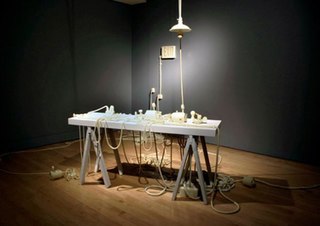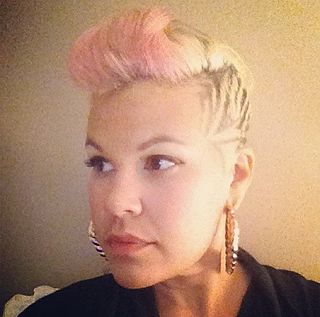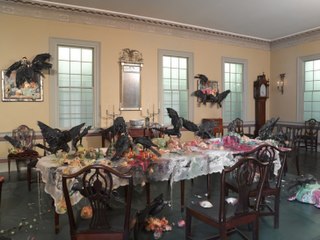Wangechi Mutu is a Kenyan-born American visual artist, known primarily for her painting, sculpture, film, and performance work. Born in Kenya, she has lived and established her career in New York City for more than twenty years. Mutu's work has directed the female body as subject through collage painting, immersive installation, and live and video performance while exploring questions of self-image, gender constructs, cultural trauma, and environmental destruction and notions of beauty and power.

Hannah Wilke was an American painter, sculptor, photographer, video artist and performance artist. Wilke's work is known for exploring issues of feminism, sexuality and femininity.
Judy Pfaff is an American artist known mainly for installation art and sculptures, though she also produces paintings and prints. Pfaff has received numerous awards for her work, including a John D. and Catherine T. MacArthur Foundation Fellowship in 2004 and grants from the John Simon Guggenheim Memorial Foundation (1983) and the National Endowment for the Arts. Major exhibitions of her work have been held at the University of Wisconsin–Madison, the Denver Art Museum and Saint Louis Art Museum. In 2013 she was elected to the American Academy of Arts and Sciences. Video interviews can be found on Art 21, Miles McEnery Gallery, MoMa, Mount Holyoke College Art Museum and other sources.
Jean Shin is an American artist living in Brooklyn, NY. She is known for creating elaborate sculptures and site-specific installations using accumulated cast-off materials.

Jessica Stockholder is a Canadian-American artist known for site-specific installation works and sculptures that are often described as "paintings in space." She came to prominence in the early 1990s with monumental works that challenged boundaries between artwork and display environment as well as between pictorial and physical experience. Her art often presents a "barrage" of bold colors, textures and everyday objects, incorporating floors, walls and ceilings and sometimes spilling out of exhibition sites. Critics suggest that her work is informed by diverse artistic traditions, including abstract expressionism, color field painting, minimalism and Pop art. Since her early career, they have noted in her work an openness to spontaneity, accident and marginality and a rejection of permanency, monetization and disciplinary conventions that Stephen Westfall characterized as an "almost shocking sense of freedom."

María Elena González is a Cuban-American sculptor based in Brooklyn and the Bay Area. She is known for objects, installations and public art that interweave post-minimalist form, conceptual art and concern for materials and craft. Her early work explored themes of memory, family, identity, loss and dislocation through formal, architectural and mapping modes that address site, place and social circumstances; her later work makes connections between nature and art, engaging a broad range of media and sensory experience. In 2020, artist and scholar Ellen Levy wrote "González's art re-invents nature as culture" through an "exquisite attunement" that uncovers formal and thematic analogies between both realms and synesthetic connections between visual and aural senses.

Jeanne Silverthorne is an American sculptor, known for cast-rubber sculptures and installations that explore the artist's studio as a metaphor for artistic practice, the human body and psyche, and mortality. She gained prominence in New York City in the 1990s, as one of several material-focused sculptors who critiqued the austere, male-dominated Minimalist movement by embracing humble, unorthodox media and hand-made, personal and ephemeral qualities championed by artists such as Eva Hesse and Louise Bourgeois. She treats the studio as a physical and conceptual site to be excavated, documented and inventoried, examining in the words of Sculpture's Jan Riley "the end of studio arts … and the impossibility of this mode of expression regaining its former creative validity and vitality in today’s world." Art in America critic Raphael Rubinstein wrote that, like the late studio paintings of Philip Guston, Silverthorne examines "deeply melancholic realms, enlivened by the occasional mordant joke, in which lowly objects are relentlessly and lovingly queried for a meaning they never seem quite ready to yield."
R. H. Quaytman is an American contemporary artist, best known for paintings on wood panels, using abstract and photographic elements in site-specific "Chapters", now numbering 35. Each chapter is guided by architectural, historical and social characteristics of the original site. Since 2008, her work has been collected by a number of modern art museums. She is also an educator and author based in Connecticut.

Heather T. Hart is an American visual artist who works in a variety of media including interactive and participatory Installation art, drawing, collage, and painting. She is a co-founder of the Black Lunch Table Project, which includes a Wikipedia initiative focused on addressing diversity representation in the arts on Wikipedia.
Rona Pondick is an American sculptor. She lives and works in New York City. Using the language of the body in her sculpture, in both a literal and a metaphorical sense, has been of interest to Pondick since the beginnings of her career in 1977. An abiding concern of hers has been the exploration of the use of different materials, a consistent motif that runs throughout her work from its beginnings to the present day.

Lenore Malen is an American artist who creates video installations, photography, and performance. Malen was awarded a Guggenheim fellowship and a NYFA Grant in Interdisciplinary Art in 2009.
Joyce J. Scott is an African-American artist, sculptor, quilter, performance artist, installation artist, print-maker, lecturer and educator. Named a MacArthur Fellow in 2016, and a Smithsonian Visionary Artist in 2019, Scott is best known for her figurative sculptures and jewelry using free form, off-loom beadweaving techniques, similar to a peyote stitch. Each piece is often constructed using thousands of glass seed beads or pony beads, and sometimes other found objects or materials such as glass, quilting and leather. In 2018, she was hailed for working in new medium — a mixture of soil, clay, straw, and cement — for a sculpture meant to disintegrate and return to the earth. Scott is influenced by a variety of diverse cultures, including Native American and African traditions, Mexican, Czech, and Russian beadwork, illustration and comic books, and pop culture.

Mary Miss is an American artist and designer. Her work has crossed boundaries between architecture, landscape architecture, engineering and urban design. Her installations are collaborative in nature: she has worked with scientists, historians, designers, and public administrators. She is primarily interested in how to engage the public in decoding their surrounding environment.
Cosima von Bonin is a German contemporary artist whose practice includes sculptures, textiles, sound, film, and performances. Von Bonin draws inspiration from the intellectual, artistic, and musical culture of her neighborhood in Cologne, Germany, where she lives and works with her husband, Michael Krebber. She is known for being a political artist as well as by her humor, aquatic caricatures, and use of pop-culture characters, such as Daffy Duck.

Valerie Hegarty is an American painter, sculptor, and installation artist. She is known for irreverent, often critical works that replicate canonical paintings, furnishings, and architectural spaces from American or personal history undergoing various processes of transformation. Hegarty most often portrays her recreations in meticulously realized, trompe l’oeil states of decay, ruin, or physical attack related to their circumstances. Her work examines American historical themes involving colonization, slavery, Manifest Destiny, nationalism, art-historical movements and their ideological tenets, romantic conceptions of nature, and environmental degradation. Sculpture critic Robin Reisenfeld wrote that among other things, Hegarty's art is "informed by 19th-century American landscape painting as an expression of the sublime, as well as by the manufacturing of two-dimensional 'masterworks' to be destroyed in three-dimensional fashion in order to evoke entropic forces of growth and decay."

Nade Haley was an American visual artist whose work has been exhibited at numerous museums and galleries, and is held in public and private collections. After relocating from Washington DC, Haley lived and kept studios in New York City and in Cape Breton, Nova Scotia.

Ellen Driscoll is a New York-based American artist, whose practice encompasses sculpture, drawing, installation and public art. She is known for complex, interconnected works that explore social and geopolitical issues and events involving power, agency, transition and ecological imbalance through an inventive combination of materials, technologies, research and narrative. Her artwork often presents the familiar from unexpected points of view—bridging different eras and cultures or connecting personal, intimate acts to global consequences—through visual strategies involving light and shadow, silhouette, shifts in scale, metaphor and synecdoche. In 2000, Sculpture critic Patricia C. Phillips wrote that Driscoll's installations were informed by "an abiding fascination with the lives and stories of people whose voices and visions have been suspended, thwarted, undermined, or regulated." Discussing later work, Jennifer McGregor wrote, "Whether working in ghostly white plastic, mosaic, or walnut and sumi inks, [Driscoll's] projects fluidly map place and time while mining historical, environmental, and cultural themes."
Caitlin Cherry is an African-American painter, sculptor, and educator.
Rico Gatson is a multidisciplinary artist working in Brooklyn, New York, whose work draws from his African-American background. Through his art, he provides social commentary on significant moments in African-American history. His work combines abstract patterns with vibrant colors, which creates confrontational work that references African American culture and history.

Heide Fasnacht is a New York City-based artist who works in sculpture, drawing, painting and installation art. Her work explores states of flux, instability and transformation caused by human action and natural events. Since the mid-1990s, she has been known for sculptures and drawings that recreate momentary phenomena such as sneezes, geysers and demolitions—in sometimes abstract or cartoony form—that are temporally and spatially "frozen" for consideration of their aesthetic, perceptual, social or sensate qualities. In the late 2010s, she has expanded these themes in paintings that examine lost and neglected childhood sites, such as playgrounds and amusement parks. ARTnews critic Ken Shulman has described her work as "chart[ing] the fluid dialogue between second and third dimensions, motion and inertia, creation and ruin."














